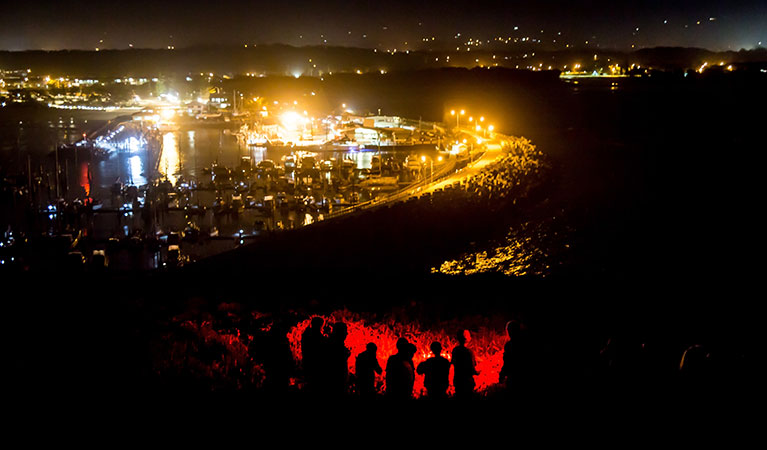School excursion
Muttonbirds by moonlight
Muttonbird Island Nature Reserve
Open, check current alerts
Overview
Join us at twilight for a fascinating exploration of Muttonbird Island and its nesting rookery for thousands of wedge-tailed shearwaters. This Stage 2 (Years 3-4) Geography excursion examines the features and characteristics of this unique place and environment.
Read more about Muttonbirds by moonlight
Students explore the ways people interact with this place and how this special place and its seasonal visitors are protected.
As the sun sets over Coffs Harbour, thousands of wedge-tailed shearwaters (muttonbirds) return to their nesting burrows on Muttonbird Island. Here, their hungry partners or chicks await.
Through direct observation of the birds and their environment, students will learn about the life and breeding cycles of these fascinating animals. Well discover why they travel such vast distances to breed and learn about the adaptations that support them in this.
Students will learn about the role of muttonbirds in the cultural and spiritual life of the Gumbaynggirr People, the traditional custodians of this place.
Students acquire and communicate geographical information using geographical tools for inquiry utilising maps and pictures and have the opportunity to observe and record data about birds and burrows.
Students will discuss the impacts of visitors both human and non-human to the island and how these impacts are managed. Together well examine concepts of place, space, interconnection and sustainability to develop a rich understanding of this coastal haven.
This excursion is designed to support the K-10 geography syllabus topic The Earth’s Environment.
For program outline, safety and practical information about this excursion, see info for teachers
| Stage | Stage 2 (Years 3-4) |
|---|---|
| Learning area | Geography |
| Student outcomes |
GE2-1. Examines features and characteristics of places and environments GE2-2. Describes the ways people, places and environments interact GE2-3. Examines differing perceptions about the management of places and environments |
| Objectives |
Students will:
|
Excursion details
- When
- Only available between the months of August to April when the shearwaters are present on the island.
- Availability
- Guided. Available on request.
- Duration
- 1hr 30min
- Grading
- Medium
- Price
-
$290 per group (includes GST). Maximum 20 students per group. For groups over 20 conditions apply.
- Accessibility
- Medium
- Meeting point
- The outdoor learning centre located at the base of Muttonbird Island.
- Equipment
provided - Yes
- Booking
- If you would like to organise a NPWS school excursion please get in touch with local staff or use the 'Enquire' link for the online form.
Local alerts
For the latest updates on fires, closures and other alerts in this area, see https://www.nationalparks.nsw.gov.au/education/stage-2-geography-muttonbirds-by-moonlight/local-alerts
Operated by
- School excursion inquiries - North Coast
- 02 6657 5935
- npws.northcoasteducation@environment.nsw.gov.au
Park info
- in Muttonbird Island Nature Reserve in the North Coast region
Muttonbird Island Nature Reserve is always open but may have to close at times due to poor weather or fire danger.
Info for teachers
All the practical information you need to know about Muttonbirds by moonlight.
Program outline
- Welcome, acknowledgement of Country and safety briefing
- Share in Dreamtime stories and learn about the cultural significance of the island
- Split into groups (1:20)
- Examine the nesting rookery of muttonbirds and discuss their adaptations and unique breeding cycle
- Discuss the broader ecosystem and connection between all living things here
- Farewell and depart
What to bring
Please wear long pants, closed, comfortable shoes and bring a hat and sunscreen. Be ready for all weather conditions with a jumper and raincoat. Remember to bring extra food and water, and any necessary medications. Please bring your belongings in a backpack rather than a plastic bag.
Maps and downloads
Risk assessment and risk benefits
Our rangers and guides have the technical skill and experience to assess the risks and the benefits of a variety of activities delivered as part of our learning programs.
We believe in including opportunities that allow students to learn and experience for themselves through exploration in the natural environment.
Please make your own risk assessment based on the information provided. Detailed potential risks and controls are provided for the site to assist teachers in risk management planning. Teachers and carers should be aware of, and consider the needs, abilities and medical conditions of students when visiting this site. The supervision of students remains the responsibility of the teacher. The school must ensure an adequate number of adult supervisors are present.
Accessibility
Disability access level - medium
The outdoor learning centre is wheelchair accessible. The Muttonbird Island walking track includes sections of steps, a narrow path and steep gradients. It is not considered wheelchair accessible.

